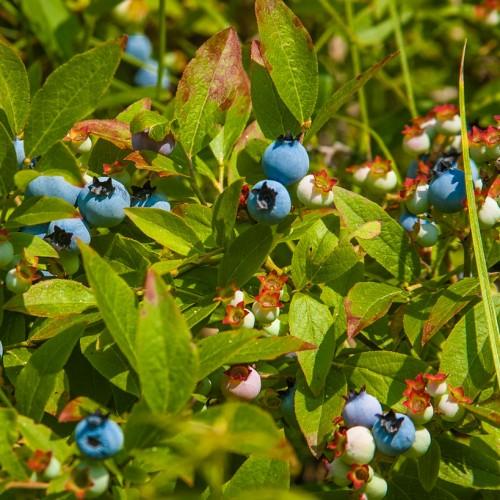
highbush blueberry
Vaccinium corymbosum
Cycle:
Perennial
Watering:
Frequent
Hardiness Zone:
5 - 8
Flowers:
Flowers In Spring
Sun:
Full sun,part shade
Soil:
Sandy Loamy Humus Rocky
Fruits:
Fruits In Summer Ready In Autumn
Edible:
Yes
Leaf:
Yes
Growth Rate:
High
Maintenance:
Moderate
watering
Highbush blueberry (Vaccinium corymbosum) plants should be watered deeply once or twice a week, depending on the regional climate and soil type. In areas with cooler temperatures and more rain, 1-2 deep waterings per week is usually enough. In areas with hotter, drier climates, plants should be watered more frequently, at least twice a week. In addition, established blueberry bushes should be mulched heavily in order to help retain moisture in the soil. If the soil feels dry to the touch, water the bush to a depth of 6–8 inches or until the topsoil is moist. It is important to allow the soil to dry somewhat between waterings.
sunlight
Highbush blueberry (Vaccinium corymbosum) needs full sun for best growth and fruit production. It should receive at least 6-8 hours of direct sunlight each day in a well-drained, slightly acidic soil. Full sun means that the location receives at least 6 hours of direct sunlight each day, with no shade from trees or other objects during the peak of the day (about 11am to 3pm). During the late spring and early summer when the fruit is maturing, additional sunlight may be beneficial. Highbush blueberry is very tolerant of cold temperatures and can withstand temperatures as low as -30° Fahrenheit.
pruning
Highbush blueberries (Vaccinium corymbosum) require regular pruning to keep the bush healthy and productive. Pruning is typically done every winter or early spring, and can help to improve air flow, prepare for flowers and fruit, increase yield, and prevent disease. When pruning, make sure to remove any diseased or damaged wood, weak or old canes that are not producing fruit, and any branches that are rubbing against each other. Also, shorten or remove any canes that are too long, and thin the bush to increase air flow. Finally, trim any overhanging canes to maintain the desired height and shape of the bush. Be sure to take a slow and cautious approach when pruning, as too much can have negative effects on your bush’s health in the future.
